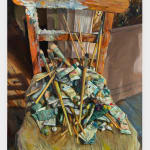
Rebecca Ness American , 1992
Painter’s chair, 2025
Oil on linen
101.6 x 76.2 cm. (40 x 30 in.)
Copyright The Artist
Further images
Rebecca Ness works within a lineage of figurative painters. David Hockney and Norman Rockwell provide important touchstones, but her deepest debt is to her artistic hero, Lucian Freud. Painter’s chair...
Rebecca Ness works within a lineage of figurative painters. David Hockney and Norman Rockwell provide important touchstones, but her deepest debt is to her artistic hero, Lucian Freud. Painter’s chair (2025) was made after a visit to Freud’s London studio. It is a portrait in absentia: a chair piled with mottled brushes and crumpled tubes of paint, its surface thick with oil stains and smears. Freud is present only through residue, conjured in the tools that outlive him.
Ness paints Freud’s paint in the manner of his painting, yet always on her own terms. The work becomes a reflexive homage, a study in influence, artistic lineage, and the complexities of inheritance. It reveals the sharp intelligence and wit that thread through her practice.
Freud is often associated with froideur, a pursuit of precision and the cool facts of flesh. He once remarked that he treated the head as “just another limb.” Ness moves differently. Her realism is intimate, adaptive. She bends what she sees in service of narrative, summoning not only the thing itself but the world as she imagines it. Even here, painting Freud’s paint, her voice is unmistakably her own.
At heart a narrative painter, Ness refuses to let objects remain mute. Painter’s chair is not merely a study of a studio interior but a record of her encounter with it – and with him. Her canvases are thick with details that advance a story. In this work, a shadow falls across the chair: the artist’s own, cast over her hero. The shadow fixes the moment to a particular time of day, anchoring the scene in the everyday. A momentous encounter is lodged within the ordinary, and it is in this tension – between reverence and the mundane – that Ness situates her art.
Ness paints Freud’s paint in the manner of his painting, yet always on her own terms. The work becomes a reflexive homage, a study in influence, artistic lineage, and the complexities of inheritance. It reveals the sharp intelligence and wit that thread through her practice.
Freud is often associated with froideur, a pursuit of precision and the cool facts of flesh. He once remarked that he treated the head as “just another limb.” Ness moves differently. Her realism is intimate, adaptive. She bends what she sees in service of narrative, summoning not only the thing itself but the world as she imagines it. Even here, painting Freud’s paint, her voice is unmistakably her own.
At heart a narrative painter, Ness refuses to let objects remain mute. Painter’s chair is not merely a study of a studio interior but a record of her encounter with it – and with him. Her canvases are thick with details that advance a story. In this work, a shadow falls across the chair: the artist’s own, cast over her hero. The shadow fixes the moment to a particular time of day, anchoring the scene in the everyday. A momentous encounter is lodged within the ordinary, and it is in this tension – between reverence and the mundane – that Ness situates her art.
